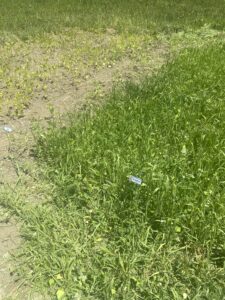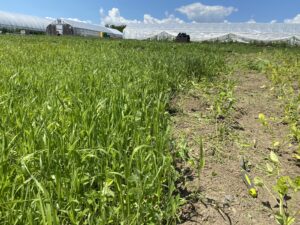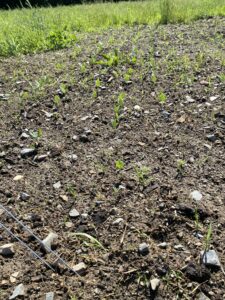Final report for GNE22-284
Project Information
With intensifying climate change, NE farmers are facing more frequent and damaging instances of drought. Long periods of summer heat can cause summer slump, the decline in growth of cool season species. In various animal production systems, from corn silage to pasture, the addition of warm season forage legumes has the potential to increase available nitrogen, soil moisture and overall productivity. Traditionally the primary legumes in northeastern pastures, which are essential for maintaining protein rich livestock diets and soil fertility, were all cool-season legumes, which are particularly prone to summer slump and failure in prolonged droughts. There are two warm season legumes with underexplored potential in the northeast. Cowpea, a well-studied warm season forage legume, which has historically been cultivated in the southern US or tropical and sub-tropical environments globally, and mung bean, which has a very short phenology well adapted to short periods of intense heat. Utilizing mung bean and cowpea will increase the overall sustainability, yield, and decrease the need for fertilizers and soil amendments. By investigating these warm season legumes as an alternative to warm season grasses in hayfields and with potential expansion to vegetable and animal farming operations as a dual-purpose grain and hay crop, revenue opportunities well be expanded in addition to the positive ecological benefits. Warm season legumes intercropped in traditional corn silage systems will demonstrate their ecological benefits by decreasing inputs, while increasing overall soil health. Both practices will increase the resiliency of Vermont farm systems, while diversifying farm revenues and practices.
The current proposal aims to help improve the sustainability and productivity of forage crops with the introduction of the warm season legumes, cowpea and mung bean, into Northeastern systems.
- Evaluate cowpea and mung bean performance in Vermont hay systems. Determine forage and grain quality when utilized for dual purposes, to diversify farm operations.
- Evaluate cowpea and mung bean performance as a cover crop in corn silage systems and silage quality when used with corn.
The purpose of this project is to increase the biodiversity and sustainability of Vermont’s ruminant animal forage systems by utilizing warm season legumes. Northeastern (NE) pastures are typically dominated by cool season grasses and legumes due to the harsh winters. Although highly productive and hardy enough to survive freezing temperatures, their growth slows during the summer months when there is hot and dry weather. This hot weather leads to “summer slump” or the slowing and dormancy of the cool season crops (Darby et al., 2015). Summer annuals are great alternative to perennial forage systems, when facing summer slump. Warm season grasses like sorghum, sudangrass and millet have been investigated in the NE, but there is minimal research on warm season legumes (Darby et al., 2012). With shifting weather patterns due to climate change, NE summers will become warmer with increased instances of drought or rainfall. Vermont is already experiencing this, with an average temperature increase of 2°F since 1900 and warm seasons becoming wetter and longer. With temperatures rising year-round, winters are becoming milder (vtclimate.org, accessed 2022, Mar. 12). Although these changes could be perceived beneficial, Vermont will continue to experience increased spring and fall rains, further constricting the yield and productivity of warm season forages or silage crops due to delayed plantings. These environmental changes will exasperate summer slump and decrease productivity of Northeast farms during the already limited growing season.
Many Vermont dairy and beef farmers rely on corn silage, hay, or pasture to feed their cattle. These systems are typically monocrops, apart from pastures, and require some sort of nutrient application to maximize yield. As farm sustainability becomes more important, there is an increased interest in intercropping, diversification of monocrop systems, and diversified rotational practices. Diversification of monocultures and other traditional agricultural systems not only increases sustainability but increases soil microbial diversity which has beneficial effects on soil structure and overall soil health (Kleppel 2019). Legumes fix atmospheric nitrogen due to their symbiotic relationship with Rhizombium bacteria (Collins et al., 1986). Beyond their nitrogen fixing capabilities, legumes also sequester atmospheric carbon (Bybee-Finley et al., 2016). The addition of legumes to forage and hay systems increases farm sustainability. They also reduce fertilizer inputs while maintaining or increasing yields. Cowpea, Vigna unguiculata (L.) Walp, is frequently grown by subsistent African farmers for both grain and as fodder, which if adopted by American farmers can further diversify their operations beyond beef or dairy farming. Mung bean, Vigna radiata (L.) Wilzcek, is commonly grown in tropical climates in a rotation with wheat and rice, being planted before the rainy season and being harvested before rice fields are flooded (Dahiya et al., 2015). Similarly to cowpea, the grain can be harvested for human consumption along with the arial plant parts being utilized as animal fodder. For the reasons stated above, warm season forage legumes increase farm sustainability, biodiversity, and farm income diversity. All of which will serve to benefit farmer livelihoods while allowing them to continue being good stewards of the land.
Research
Field Site: The experiment will take place at the University of Vermont's’ Horticulture Research and Education Center located at 65 Green Mountain Drive, South Burlington, VT 05403 and at Borderview Research Farm located at 487 Line Rd, Alburg, VT 05440.
Seed material and inoculate was obtained from: Turner Seed (US-183, Breckenridge, TX 76424), Greencover Seed (918 Rd X, Bladen, NE 68928) and Hancock Seed (18724 Hancock Farm Rd, Dade City, FL 33523). Cowpea seed varieties are “Iron & Clay,” “Red Ripper,” and “Ace” with the well-known Iron & Clay forage cultivar utilized as the check. The mung bean variety is “OK2000” which was the only commercially available forage mung bean variety. There is a need for more forage mung bean breeding efforts, and should new varieties become available, I will include them in this work.
Objective 1: Evaluate cowpea and mung bean performance in Vermont hay systems. Determine forage and grain quality when utilized for dual purposes, to diversify farm operations.
Experiment 1: Testing for hay quality, seed quality, viability of dual forage and seed harvest in Northeastern growing conditions.
To evaluate cowpea and mung bean’s performance in a Vermont hay system, the 4 cultivars will be planted in a complete randomized block design with two planting densities with rows sown at 15 cm and 30 cm row spacing. Soil samples will be taken before sowing to determine any necessary soil amendments or adjustments and tested at the UVM soil testing lab. The legumes will be drill seeded to 1” deep once nighttime temperatures consistently reach 18°C or mid-June. To investigate a dual system, Iron & clay and OK2000 will be sown at 30 cm row spacings and grown until pods are desiccated. Once pods have fully dried, they will be harvested and evaluated for yield and 100 seed weight, then the remaining biomass will be cut for hay. There will be three replicates of each variety at the two planting densities and for the dual system, with Iron & Clay serving as the control at the 30 cm density. This reflects the recommended seeding rate of 15-30 lbs/acre dependent on seed weight, in 1.22 m x 4.57 m plots and 30 plots total (Henning & Kilian, 2017: Dareus et al., 2021). Plant height and biomass will be taken at 45, 60, 90 days and at harvest by taking two 0.25 m2 quadrats per plot cut at the soil level and dried in a 50°C oven for 7 days. Samples will be taken from center rows to avoid any variation at the edges of the plots. Plant growth habit, pod formation, days to flowering and nodule presence will be recorded. The first hay cut will be made 60 days after sowing and the final hay cut being made at the end of the growing season (Oushy 2012). At the end of the growing season, any pods will be harvested, noting yield, pod length and 100 seed weight. Dried samples will be ground to the appropriate size and tested for hay quality by using near infrared spectroscopy technique (NIRS) (Marten et al., 1985). NIRS will test starch, crude protein (CP), Lignin, Ash, ADF and NDF.
To analyze the results, an analysis of variance (ANOVA) test will be used along with a Tukey honest significant difference test to compare treatments. The factors used will be planting density and cultivar. An independent-test will be utilized to analyze the dual-system hay and grain results.
Experiment 2: Evaluate cowpea and mung bean performance as a cover crop in corn silage systems.
To test for performance in corn silage systems, two cowpea and one mung bean variety will be inter-seeded between rows of corn with 30 cm row spacings, with one untreated check. The plots will be organized in a complete randomized block design with 3 replicates for each treatment. Soil samples will be taken, and fields prepared as a conventional corn silage field would be prepared with spraying for weeds prior to sowing. The varieties used will be Red Ripper, Iron & Clay and OK2000; a prostrate cowpea, upright cowpea and mung bean variety. The legumes will be drill seeded to 1” deep 4 weeks after the corn is sown into plots 2.13 m x 6.1 m and a total of 12 plots. Plant height and biomass will be taken at 45 days and at harvest by taking two 0.25 m2 quadrats per plot cut at the soil level and dried in a 50°C oven for 7 days. Samples will be taken from center rows to avoid any variation at the edges of the plots. Plant height will also be recorded at 30 days, 45 days, 60 days and at harvest. Corn silage will be harvested at the end of the season using a John Deere row chopper and silage will be processed, recording overall yield. Silage quality and cover crop quality will be assessed utilizing NIRS to test starch, crude protein, Lignin, Ash, ADF and NDF (Marten et al., 1985).
The same analysis method will be used as the first objective; an ANOVA test and a Tukey post-hoc test will be used to evaluate the difference between the legumes when intercropped in corn silage.
Experiment 1 was not completed after year 1 due to such poor establishment and the unlikeliness of farmer adoption for such a high input hay crop. Experiment 2 was expanded to include an untreated check in year 1 and increased to 4 replicates per treatment instead of 3 reps due to the unsuccessful nature of Experiment 1. Additionally, Experiment 2 was expanded again in year 2 to include the additional untreated check and an increase to 8 replicates per treatment.
In year one, we were unsuccessful with the warm season legumes as primary hay production in Vermont. The weeds out competed the legumes and weeding efforts were not feasible at that time and unrealistic for farmers to do on a larger scale. After weeding all treatments were chlorotic and had poor establishment, potentially due to early season cold temperatures. I have attached pictures of the experiment.
As a cover crop in corn silage, all of the varieties performed well and helped discourage weed coverage and establishment. We are still evaluating the nutritional results for each treatment as potential feed/grazing after the silage harvest. There was a later planting date both years for the cover crop, which may have been beneficial for establishment and seedling resiliency.
In year two, we expanded the corn silage experiment to include double the number of replicates as described above in the methods section. After analyzing the forage data from Dairy One in both years using an ANOVA, we determined that there is a significant difference between the untreated check and the warm season legumes in both years. Based on the energy table provided by Dairy One, the TDN (total digestible nutrients) were not significantly differentiated by treatment, however, in year '23 the warm season legumes had 10+ more Mcal/lb when compared to the untreated check. Interestingly enough in all years, NEL (net energy for lactation), NEM (net energy for maintenance), and NEG (net energy for gain) were significantly influence by treatment, suggesting that warm season legumes intercropped with corn silage would be a positive addition to a healthy diet for cattle at all life stages, as fed and as DM (dry matter). Similarly, horse DE (digestible energy) was significantly differentiated by treatment, with a significant p-value of (0.0068-'22 and 0.0459-'23) and an anecdotal .25 difference between untreated check and warm season legumes in '23. We were unable to test the corn silage due to harvesting methodology for any differences.
In summary, warm season legumes were unsuccessful when tested for hay production, this may require additional drill seeding or other methods to be productive, but is currently not viable in the NE. As for intercropping into corn silage and utilizing the resulting biomass as fed or DM, it was successful and results in a nutritionally beneficial addition to cattle or horse diet. Adoption of intercropping into wide-row corn silage could be a sustainable addition to corn silage production with a nutrient dense feed at the end of the season while still allowing for corn silage production and storage for winter months. We were able to address both objectives, with hay production unsuccessful and with corn silage intercropping successful and a viable addition to NE farmers operations.
Education & outreach activities and participation summary
Participation summary:
For outreach, I took part in UVM extension field day at Borderview Farm in 2022 and 2023 to share more information of intercropping corn silage and my preliminary results from the years. I also intend to publish a blog post on the UVM Legume Integration website. This publication will hopefully encourage growers to adopt warm season legumes to their rotational practices and inspire further research in cultivar improvement and overall system optimization.
Project Outcomes
We have discovered that utilizing a warm season legume intercropping in corn silage produces a grazing product suitable for cattle and horse maintenance, lactation, and gain when compared to the untreated check. Demonstrating that intercropping in corn silage could be a viable option for more sustainable production that can increase carbon sequestration and soil nitrogen.
Hay production in Vermont may not be viable if using warm season legumes only. There is space to investigate its success drill seeded into established hay fields. This project has blossomed into a participatory plant breeding project for mung bean in the North East and Mid-Atlantic regions. Mung bean for vegetable potential instead of as a forage crop has potential and much interest for farmers. A mung bean blog post will be posted on the UVM Legume website in spring 2026. This project has influenced me to explore other underutilized orphan crops and piqued my interest in seedling resiliency traits, which is addressed in the first chapter of my dissertation. Mung bean will continue to be researched as a vegetable crop in the North East, breeding genotypes more suited to the temperate climate.






